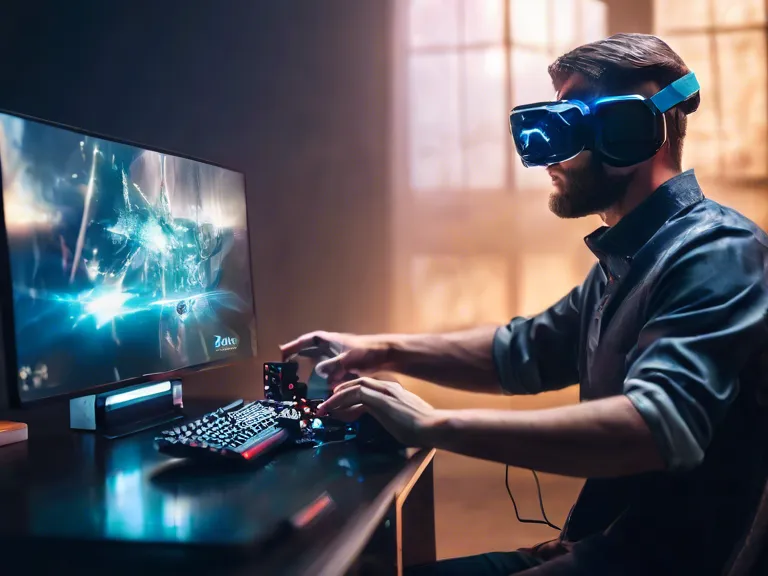Introduction
The gaming industry is evolving at a breakneck pace, and nowhere is this more apparent than in the field of game art. Real-time rendering has emerged as a game-changer, revolutionizing the way game visuals are created, delivered, and experienced. The Future of Game Art: Emerging Trends & Technologies Reshaping the Industry But what exactly is real-time rendering, and how is it redefining game art standards? In this article, we’ll explore the transformative power of real-time rendering, addressing the most pressing questions developers and gamers alike have. From its impact on artistic quality to production efficiency, prepare to discover how this technology is reshaping the future of gaming art.
What Is Real-Time Rendering and Why Does It Matter?
Real-time rendering refers to the process of generating images on-the-fly as the game runs, allowing visuals to update instantly based on player interactions. Unlike pre-rendered graphics, which require lengthy rendering times, real-time rendering delivers dynamic and responsive graphics in milliseconds.
This capability is crucial because it enables developers to create immersive worlds that respond fluidly to player actions. The direct result? Game art is no longer static or limited by pre-render constraints—it becomes a living, evolving experience that adapts in real time.
How Is Real-Time Rendering Redefining Game Art Quality?
- Hyper-Realistic Visuals Without Sacrificing Speed
- Real-time rendering engines like Unreal Engine 5 and Unity’s High Definition Render Pipeline now support photorealistic lighting, shadows, and textures. This breakthrough allows artists to push the boundaries of visual fidelity while maintaining seamless gameplay. For instance, Unreal Engine 5’s Nanite technology lets developers render billions of polygons in real time, delivering jaw-dropping detail without slowing down the game.
- Dynamic Environments and Lighting
- Static pre-rendered scenes are a thing of the past. Real-time rendering enables dynamic lighting changes that respond to environmental factors such as weather, time of day, and player actions. This elevates immersion and sets new standards for game art realism.
- Increased Artistic Flexibility
- Artists now have unprecedented creative control during development. Real-time feedback loops let them tweak textures, materials, and effects instantly, speeding up the iteration process and encouraging experimentation.
Frequently Asked Questions (FAQs) About Real-Time Rendering and Game Art
Q1: Does real-time rendering limit artistic creativity due to technical constraints?
On the contrary, real-time rendering empowers creativity. Developers can experiment with complex shaders, particle effects, and lighting without waiting hours for pre-rendered output. The result? More innovative and visually stunning art styles.
Q2: How does real-time rendering affect game production timelines?
By enabling instant visual feedback, real-time rendering drastically reduces iteration times. According to a report by Epic Games, developers using Unreal Engine 5 cut art iteration cycles by up to 50%. Faster iterations mean quicker releases and more polished products.
Q3: Is real-time rendering accessible to indie developers or just AAA studios?
Thanks to democratized tools like Unity and Unreal Engine, indie developers now harness real-time rendering to create breathtaking visuals once exclusive to AAA games. This levels the playing field and fosters greater diversity in game art.
Why Real-Time Rendering Is a Game Industry Must-Have in 2025
The gaming market is projected to exceed $300 billion globally by 2027, driven by ever-increasing consumer demand for visually rich experiences. Real-time rendering is the secret weapon developers need to meet these expectations efficiently. It’s not just a technological upgrade—it’s a strategic advantage that enhances:
- Player Engagement: Realistic, immersive visuals captivate users longer, increasing retention and monetization.
- Cross-Platform Compatibility: Real-time rendering engines optimize performance across consoles, PCs, and mobile devices, ensuring consistency.
- Future-Proofing: Developers can adapt game art for emerging technologies like VR, AR, and cloud gaming.
Top 5 Ways Real-Time Rendering Boosts Game Art Standards
- Seamless Integration of Cinematic Quality and Gameplay
- Gone are the days when cutscenes looked markedly different from in-game graphics. Real-time rendering bridges this gap, delivering cinematic experiences directly in gameplay.
- Enhanced Visual Effects and Physics
- Advanced particle systems and realistic physics simulations come alive in real time, making explosions, water, fire, and smoke more believable than ever.
- Improved Collaboration Across Teams
- Real-time visualization tools allow artists, designers, and programmers to work synchronously, reducing miscommunication and accelerating development.
- Cost Efficiency Without Compromising Quality
- Reducing pre-rendering needs slashes hardware and labor costs, making high-end visuals affordable for studios of all sizes.
- Customization and Personalization for Players
- Real-time rendering facilitates user-generated content and customizable avatars, enriching player agency and fostering community engagement.
Stories From The Frontline: How Developers Are Winning With Real-Time Rendering
Consider the success story of Fortnite, which continually updates its world using real-time rendering to introduce new content seamlessly. Epic Games credits this technology for enabling rapid content turnover and keeping millions of players engaged globally.
Similarly, Cyberpunk 2077 uses real-time ray tracing to deliver breathtaking cityscapes, setting a new visual benchmark for open-world games. These examples highlight how real-time rendering isn’t just a feature—it’s an essential pillar of modern game design.
Conclusion
Real-time rendering is undeniably redefining game art standards by blending cutting-edge technology with artistic innovation. It accelerates production, enhances realism, and empowers creators across the board. For game developers, embracing real-time rendering isn’t optional anymore—it’s imperative to stay competitive and captivate audiences in an increasingly visual marketplace.
As the gaming landscape continues to evolve, the marriage of real-time rendering and artistic vision promises to unlock experiences more immersive, responsive, and breathtaking than ever before. The future of game art is happening now, in real time.





Comments